Innovation and Sustainable Business Model Development Analysis
VerifiedAdded on 2020/03/04
|8
|1956
|44
Homework Assignment
AI Summary
This assignment delves into the concept of business models, defining them as a clear method of showcasing business operations, emphasizing value propositions, and profitability. It explores e-business archetypes, business models as activity systems, and cost-revenue architecture, highlighting the role of the internet and information technologies in reshaping business practices. The analysis includes how these conceptualizations can be applied to solve static and dynamic problems, including business model design and redesign. The assignment also addresses the significance of business context, the impact of changes in business, such as those driven by big data, and their implications for managerial decision-making. The review suggests that e-business model archetypes, business models as cost/revenue architecture, and business models as activity systems can be investigated fruitfully and in relation with one another, under the single business model theme. The importance theme which is formulated is forming, basically goes around the notion of business model, just like the new unit analysis, providing the systematic viewpoint over how to conduct business, that encompasses the activities of boundary spanning, and emphasize over value creation along with value capture. The conclusion emphasizes the importance of these findings for future business model research and practice.
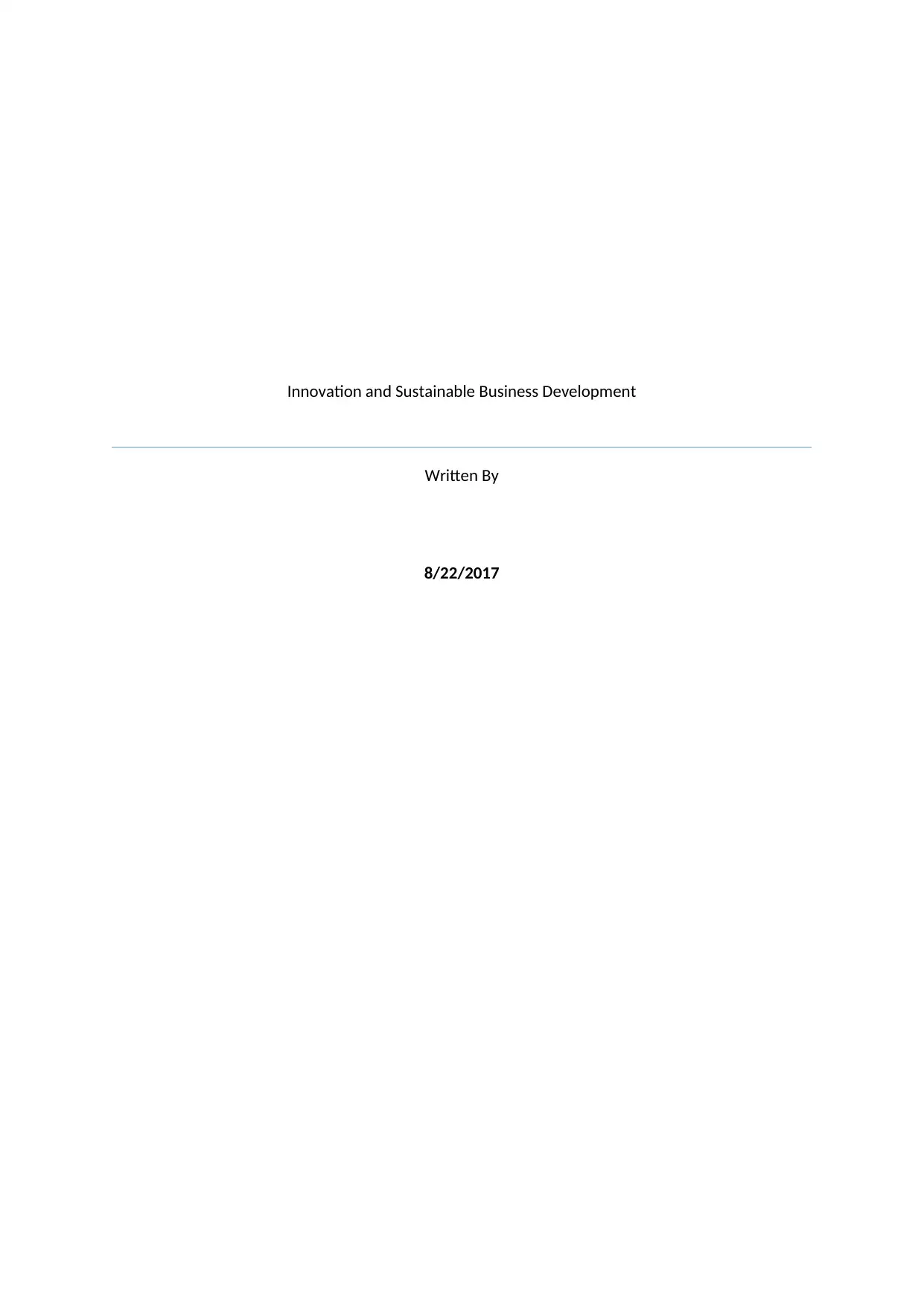
Innovation and Sustainable Business Development
Written By
8/22/2017
Written By
8/22/2017
Paraphrase This Document
Need a fresh take? Get an instant paraphrase of this document with our AI Paraphraser
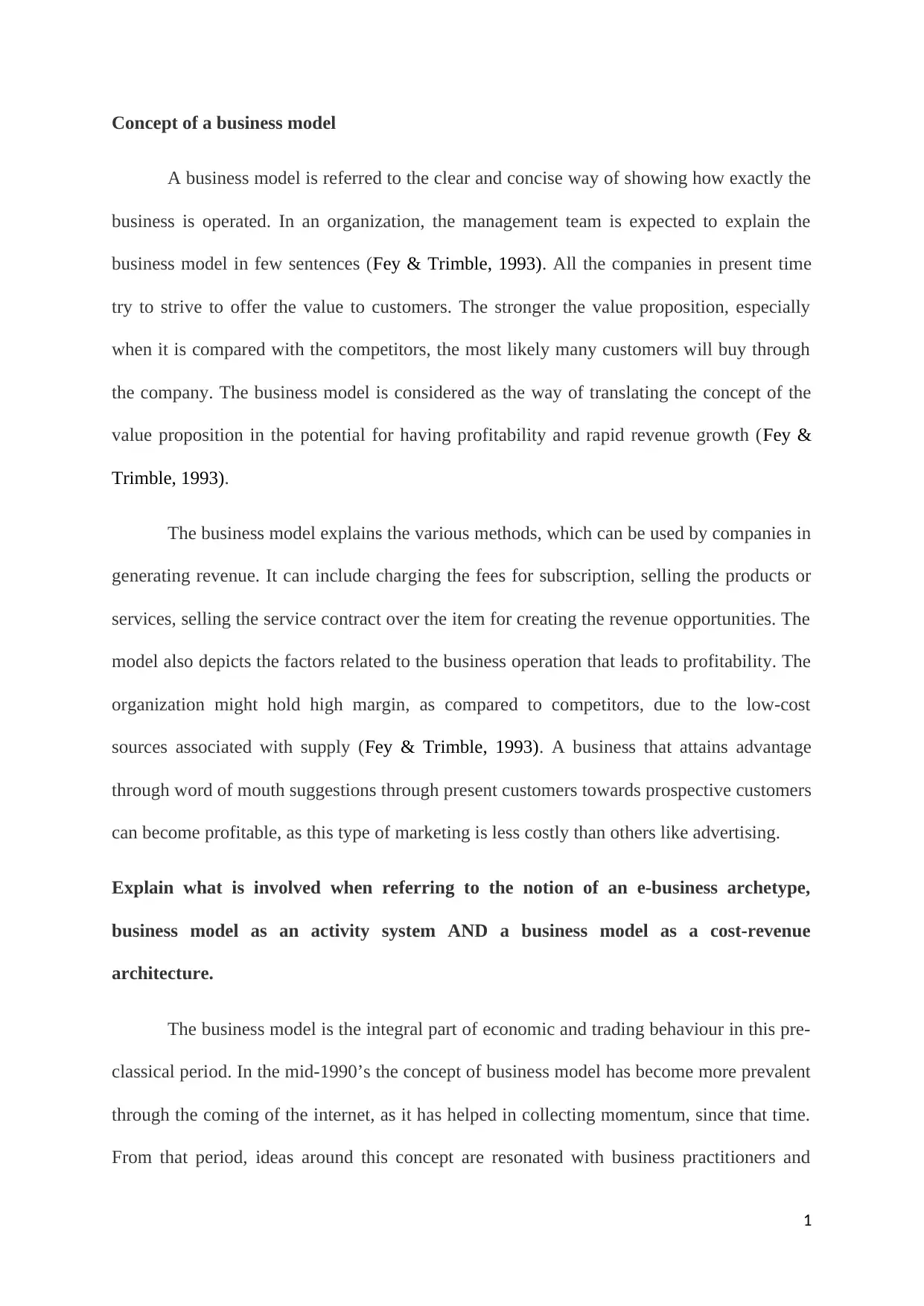
Concept of a business model
A business model is referred to the clear and concise way of showing how exactly the
business is operated. In an organization, the management team is expected to explain the
business model in few sentences (Fey & Trimble, 1993). All the companies in present time
try to strive to offer the value to customers. The stronger the value proposition, especially
when it is compared with the competitors, the most likely many customers will buy through
the company. The business model is considered as the way of translating the concept of the
value proposition in the potential for having profitability and rapid revenue growth (Fey &
Trimble, 1993).
The business model explains the various methods, which can be used by companies in
generating revenue. It can include charging the fees for subscription, selling the products or
services, selling the service contract over the item for creating the revenue opportunities. The
model also depicts the factors related to the business operation that leads to profitability. The
organization might hold high margin, as compared to competitors, due to the low-cost
sources associated with supply (Fey & Trimble, 1993). A business that attains advantage
through word of mouth suggestions through present customers towards prospective customers
can become profitable, as this type of marketing is less costly than others like advertising.
Explain what is involved when referring to the notion of an e-business archetype,
business model as an activity system AND a business model as a cost-revenue
architecture.
The business model is the integral part of economic and trading behaviour in this pre-
classical period. In the mid-1990’s the concept of business model has become more prevalent
through the coming of the internet, as it has helped in collecting momentum, since that time.
From that period, ideas around this concept are resonated with business practitioners and
1
A business model is referred to the clear and concise way of showing how exactly the
business is operated. In an organization, the management team is expected to explain the
business model in few sentences (Fey & Trimble, 1993). All the companies in present time
try to strive to offer the value to customers. The stronger the value proposition, especially
when it is compared with the competitors, the most likely many customers will buy through
the company. The business model is considered as the way of translating the concept of the
value proposition in the potential for having profitability and rapid revenue growth (Fey &
Trimble, 1993).
The business model explains the various methods, which can be used by companies in
generating revenue. It can include charging the fees for subscription, selling the products or
services, selling the service contract over the item for creating the revenue opportunities. The
model also depicts the factors related to the business operation that leads to profitability. The
organization might hold high margin, as compared to competitors, due to the low-cost
sources associated with supply (Fey & Trimble, 1993). A business that attains advantage
through word of mouth suggestions through present customers towards prospective customers
can become profitable, as this type of marketing is less costly than others like advertising.
Explain what is involved when referring to the notion of an e-business archetype,
business model as an activity system AND a business model as a cost-revenue
architecture.
The business model is the integral part of economic and trading behaviour in this pre-
classical period. In the mid-1990’s the concept of business model has become more prevalent
through the coming of the internet, as it has helped in collecting momentum, since that time.
From that period, ideas around this concept are resonated with business practitioners and
1
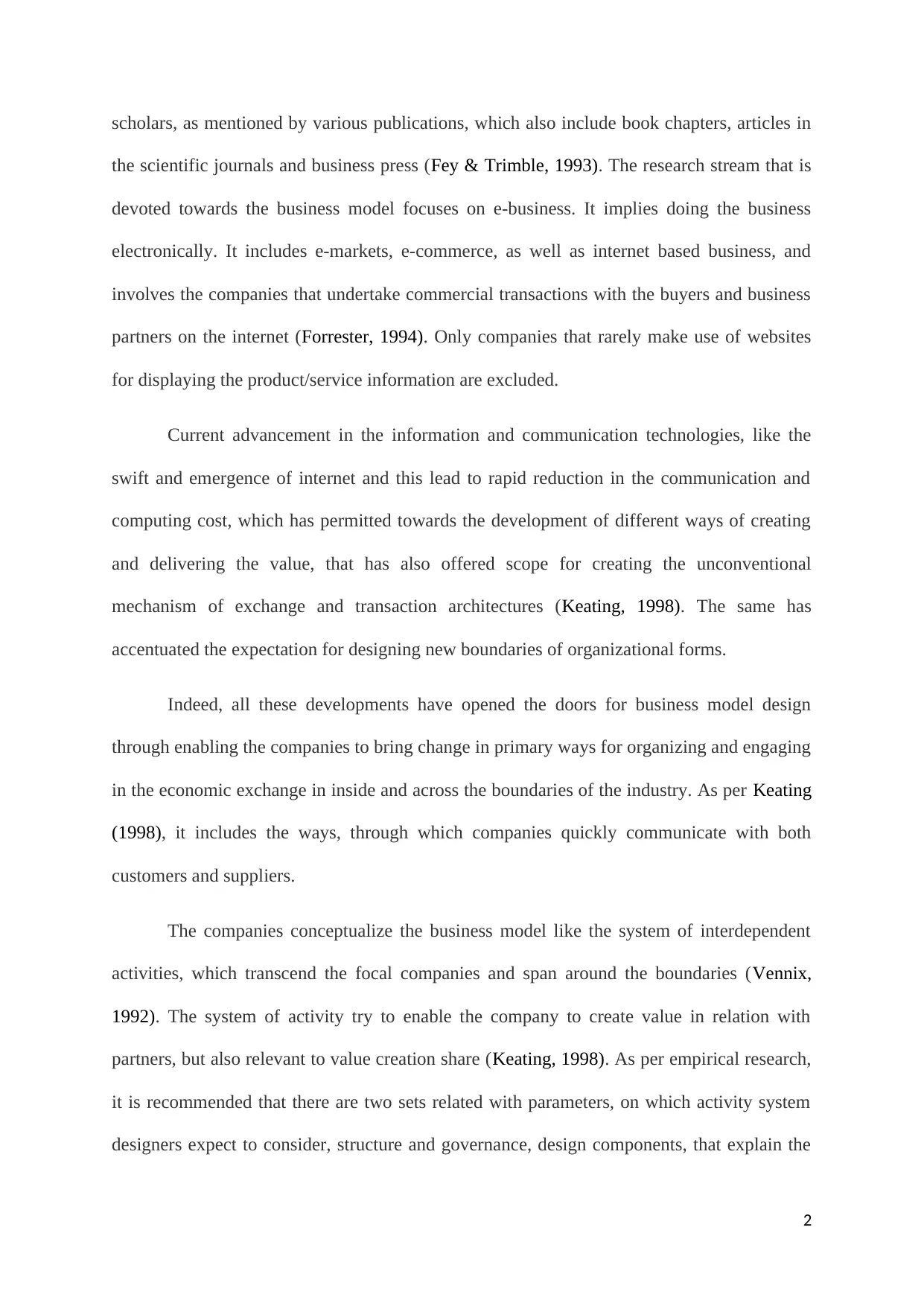
scholars, as mentioned by various publications, which also include book chapters, articles in
the scientific journals and business press (Fey & Trimble, 1993). The research stream that is
devoted towards the business model focuses on e-business. It implies doing the business
electronically. It includes e-markets, e-commerce, as well as internet based business, and
involves the companies that undertake commercial transactions with the buyers and business
partners on the internet (Forrester, 1994). Only companies that rarely make use of websites
for displaying the product/service information are excluded.
Current advancement in the information and communication technologies, like the
swift and emergence of internet and this lead to rapid reduction in the communication and
computing cost, which has permitted towards the development of different ways of creating
and delivering the value, that has also offered scope for creating the unconventional
mechanism of exchange and transaction architectures (Keating, 1998). The same has
accentuated the expectation for designing new boundaries of organizational forms.
Indeed, all these developments have opened the doors for business model design
through enabling the companies to bring change in primary ways for organizing and engaging
in the economic exchange in inside and across the boundaries of the industry. As per Keating
(1998), it includes the ways, through which companies quickly communicate with both
customers and suppliers.
The companies conceptualize the business model like the system of interdependent
activities, which transcend the focal companies and span around the boundaries (Vennix,
1992). The system of activity try to enable the company to create value in relation with
partners, but also relevant to value creation share (Keating, 1998). As per empirical research,
it is recommended that there are two sets related with parameters, on which activity system
designers expect to consider, structure and governance, design components, that explain the
2
the scientific journals and business press (Fey & Trimble, 1993). The research stream that is
devoted towards the business model focuses on e-business. It implies doing the business
electronically. It includes e-markets, e-commerce, as well as internet based business, and
involves the companies that undertake commercial transactions with the buyers and business
partners on the internet (Forrester, 1994). Only companies that rarely make use of websites
for displaying the product/service information are excluded.
Current advancement in the information and communication technologies, like the
swift and emergence of internet and this lead to rapid reduction in the communication and
computing cost, which has permitted towards the development of different ways of creating
and delivering the value, that has also offered scope for creating the unconventional
mechanism of exchange and transaction architectures (Keating, 1998). The same has
accentuated the expectation for designing new boundaries of organizational forms.
Indeed, all these developments have opened the doors for business model design
through enabling the companies to bring change in primary ways for organizing and engaging
in the economic exchange in inside and across the boundaries of the industry. As per Keating
(1998), it includes the ways, through which companies quickly communicate with both
customers and suppliers.
The companies conceptualize the business model like the system of interdependent
activities, which transcend the focal companies and span around the boundaries (Vennix,
1992). The system of activity try to enable the company to create value in relation with
partners, but also relevant to value creation share (Keating, 1998). As per empirical research,
it is recommended that there are two sets related with parameters, on which activity system
designers expect to consider, structure and governance, design components, that explain the
2
⊘ This is a preview!⊘
Do you want full access?
Subscribe today to unlock all pages.

Trusted by 1+ million students worldwide
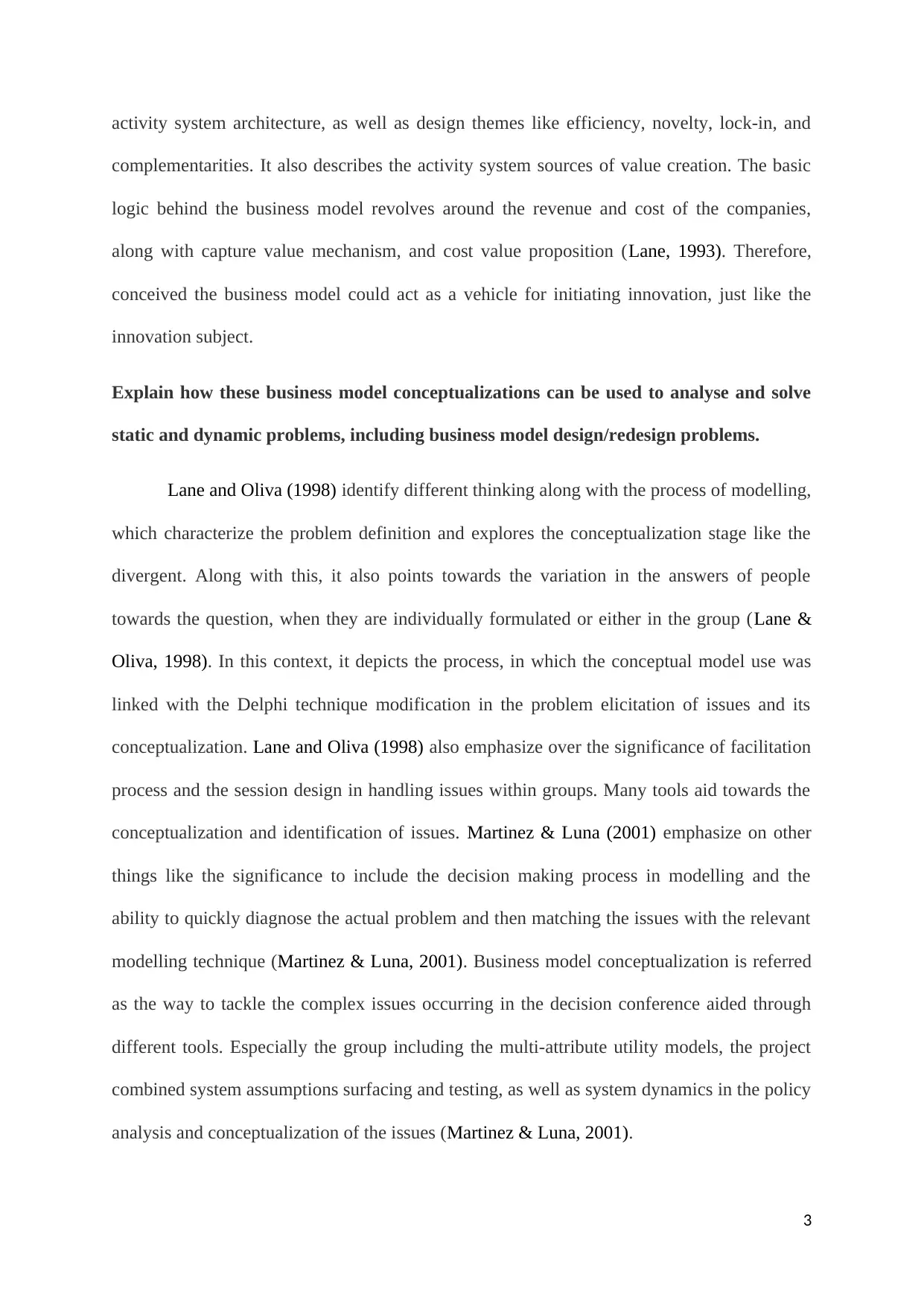
activity system architecture, as well as design themes like efficiency, novelty, lock-in, and
complementarities. It also describes the activity system sources of value creation. The basic
logic behind the business model revolves around the revenue and cost of the companies,
along with capture value mechanism, and cost value proposition (Lane, 1993). Therefore,
conceived the business model could act as a vehicle for initiating innovation, just like the
innovation subject.
Explain how these business model conceptualizations can be used to analyse and solve
static and dynamic problems, including business model design/redesign problems.
Lane and Oliva (1998) identify different thinking along with the process of modelling,
which characterize the problem definition and explores the conceptualization stage like the
divergent. Along with this, it also points towards the variation in the answers of people
towards the question, when they are individually formulated or either in the group (Lane &
Oliva, 1998). In this context, it depicts the process, in which the conceptual model use was
linked with the Delphi technique modification in the problem elicitation of issues and its
conceptualization. Lane and Oliva (1998) also emphasize over the significance of facilitation
process and the session design in handling issues within groups. Many tools aid towards the
conceptualization and identification of issues. Martinez & Luna (2001) emphasize on other
things like the significance to include the decision making process in modelling and the
ability to quickly diagnose the actual problem and then matching the issues with the relevant
modelling technique (Martinez & Luna, 2001). Business model conceptualization is referred
as the way to tackle the complex issues occurring in the decision conference aided through
different tools. Especially the group including the multi-attribute utility models, the project
combined system assumptions surfacing and testing, as well as system dynamics in the policy
analysis and conceptualization of the issues (Martinez & Luna, 2001).
3
complementarities. It also describes the activity system sources of value creation. The basic
logic behind the business model revolves around the revenue and cost of the companies,
along with capture value mechanism, and cost value proposition (Lane, 1993). Therefore,
conceived the business model could act as a vehicle for initiating innovation, just like the
innovation subject.
Explain how these business model conceptualizations can be used to analyse and solve
static and dynamic problems, including business model design/redesign problems.
Lane and Oliva (1998) identify different thinking along with the process of modelling,
which characterize the problem definition and explores the conceptualization stage like the
divergent. Along with this, it also points towards the variation in the answers of people
towards the question, when they are individually formulated or either in the group (Lane &
Oliva, 1998). In this context, it depicts the process, in which the conceptual model use was
linked with the Delphi technique modification in the problem elicitation of issues and its
conceptualization. Lane and Oliva (1998) also emphasize over the significance of facilitation
process and the session design in handling issues within groups. Many tools aid towards the
conceptualization and identification of issues. Martinez & Luna (2001) emphasize on other
things like the significance to include the decision making process in modelling and the
ability to quickly diagnose the actual problem and then matching the issues with the relevant
modelling technique (Martinez & Luna, 2001). Business model conceptualization is referred
as the way to tackle the complex issues occurring in the decision conference aided through
different tools. Especially the group including the multi-attribute utility models, the project
combined system assumptions surfacing and testing, as well as system dynamics in the policy
analysis and conceptualization of the issues (Martinez & Luna, 2001).
3
Paraphrase This Document
Need a fresh take? Get an instant paraphrase of this document with our AI Paraphraser
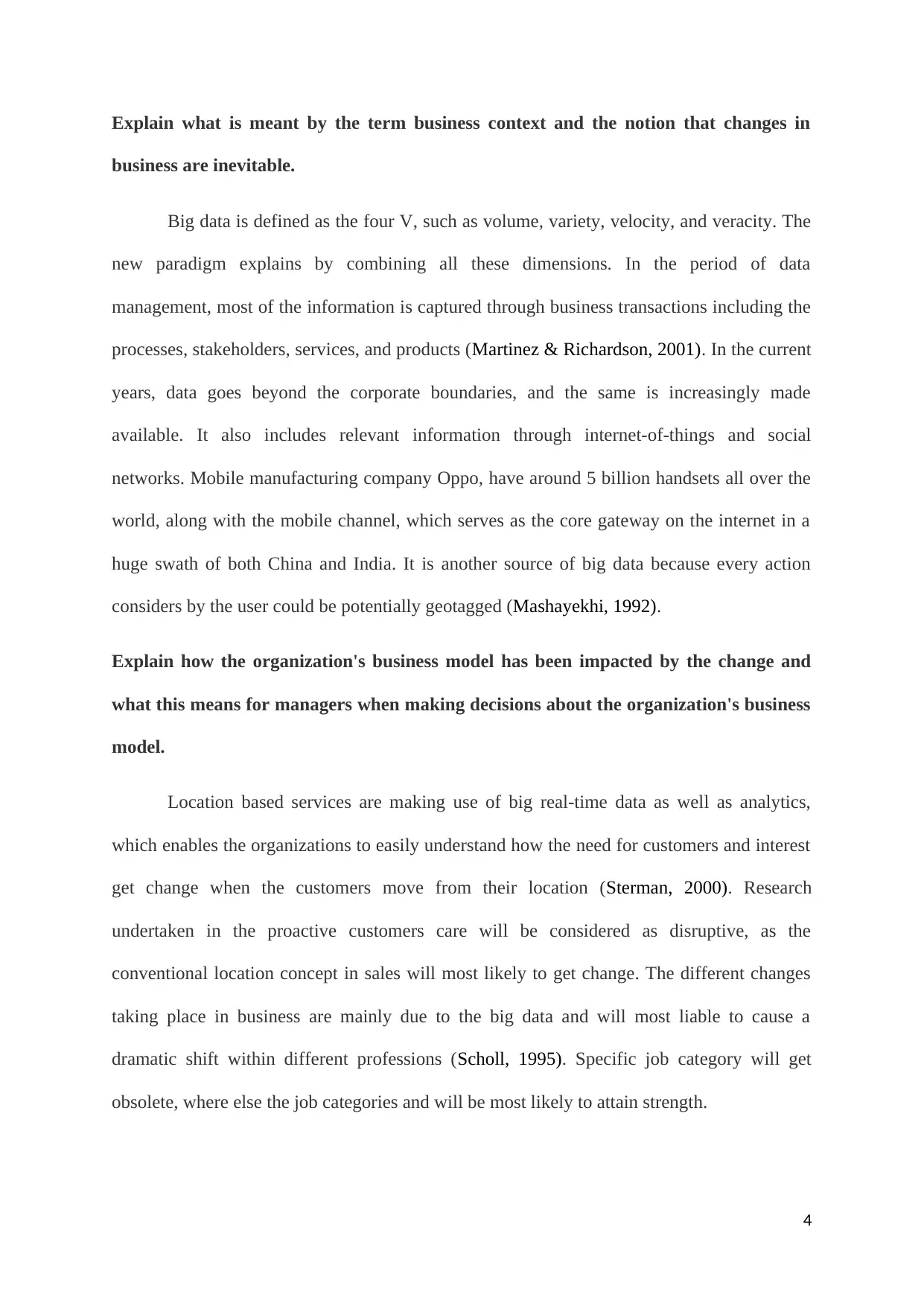
Explain what is meant by the term business context and the notion that changes in
business are inevitable.
Big data is defined as the four V, such as volume, variety, velocity, and veracity. The
new paradigm explains by combining all these dimensions. In the period of data
management, most of the information is captured through business transactions including the
processes, stakeholders, services, and products (Martinez & Richardson, 2001). In the current
years, data goes beyond the corporate boundaries, and the same is increasingly made
available. It also includes relevant information through internet-of-things and social
networks. Mobile manufacturing company Oppo, have around 5 billion handsets all over the
world, along with the mobile channel, which serves as the core gateway on the internet in a
huge swath of both China and India. It is another source of big data because every action
considers by the user could be potentially geotagged (Mashayekhi, 1992).
Explain how the organization's business model has been impacted by the change and
what this means for managers when making decisions about the organization's business
model.
Location based services are making use of big real-time data as well as analytics,
which enables the organizations to easily understand how the need for customers and interest
get change when the customers move from their location (Sterman, 2000). Research
undertaken in the proactive customers care will be considered as disruptive, as the
conventional location concept in sales will most likely to get change. The different changes
taking place in business are mainly due to the big data and will most liable to cause a
dramatic shift within different professions (Scholl, 1995). Specific job category will get
obsolete, where else the job categories and will be most likely to attain strength.
4
business are inevitable.
Big data is defined as the four V, such as volume, variety, velocity, and veracity. The
new paradigm explains by combining all these dimensions. In the period of data
management, most of the information is captured through business transactions including the
processes, stakeholders, services, and products (Martinez & Richardson, 2001). In the current
years, data goes beyond the corporate boundaries, and the same is increasingly made
available. It also includes relevant information through internet-of-things and social
networks. Mobile manufacturing company Oppo, have around 5 billion handsets all over the
world, along with the mobile channel, which serves as the core gateway on the internet in a
huge swath of both China and India. It is another source of big data because every action
considers by the user could be potentially geotagged (Mashayekhi, 1992).
Explain how the organization's business model has been impacted by the change and
what this means for managers when making decisions about the organization's business
model.
Location based services are making use of big real-time data as well as analytics,
which enables the organizations to easily understand how the need for customers and interest
get change when the customers move from their location (Sterman, 2000). Research
undertaken in the proactive customers care will be considered as disruptive, as the
conventional location concept in sales will most likely to get change. The different changes
taking place in business are mainly due to the big data and will most liable to cause a
dramatic shift within different professions (Scholl, 1995). Specific job category will get
obsolete, where else the job categories and will be most likely to attain strength.
4
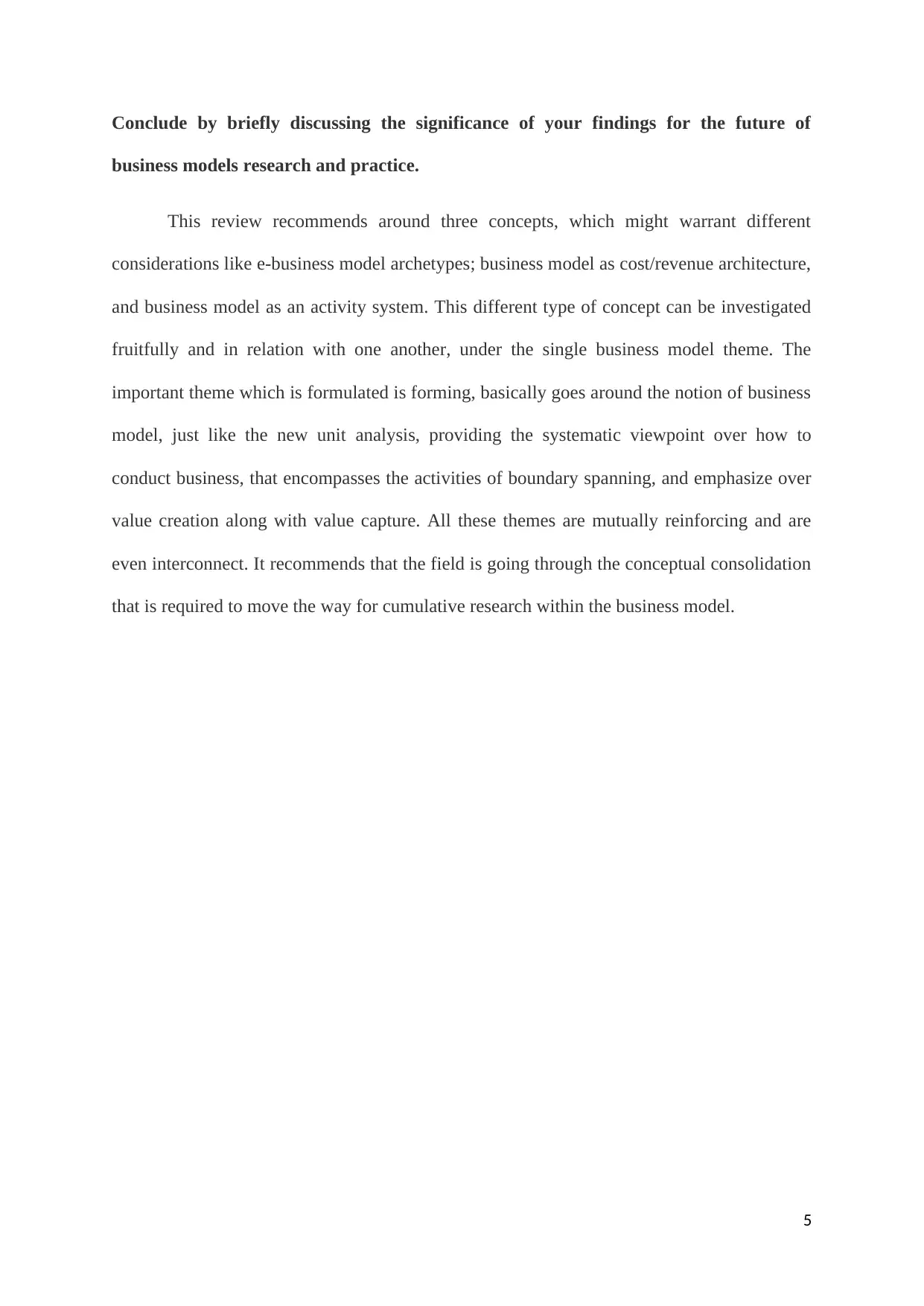
Conclude by briefly discussing the significance of your findings for the future of
business models research and practice.
This review recommends around three concepts, which might warrant different
considerations like e-business model archetypes; business model as cost/revenue architecture,
and business model as an activity system. This different type of concept can be investigated
fruitfully and in relation with one another, under the single business model theme. The
important theme which is formulated is forming, basically goes around the notion of business
model, just like the new unit analysis, providing the systematic viewpoint over how to
conduct business, that encompasses the activities of boundary spanning, and emphasize over
value creation along with value capture. All these themes are mutually reinforcing and are
even interconnect. It recommends that the field is going through the conceptual consolidation
that is required to move the way for cumulative research within the business model.
5
business models research and practice.
This review recommends around three concepts, which might warrant different
considerations like e-business model archetypes; business model as cost/revenue architecture,
and business model as an activity system. This different type of concept can be investigated
fruitfully and in relation with one another, under the single business model theme. The
important theme which is formulated is forming, basically goes around the notion of business
model, just like the new unit analysis, providing the systematic viewpoint over how to
conduct business, that encompasses the activities of boundary spanning, and emphasize over
value creation along with value capture. All these themes are mutually reinforcing and are
even interconnect. It recommends that the field is going through the conceptual consolidation
that is required to move the way for cumulative research within the business model.
5
⊘ This is a preview!⊘
Do you want full access?
Subscribe today to unlock all pages.

Trusted by 1+ million students worldwide
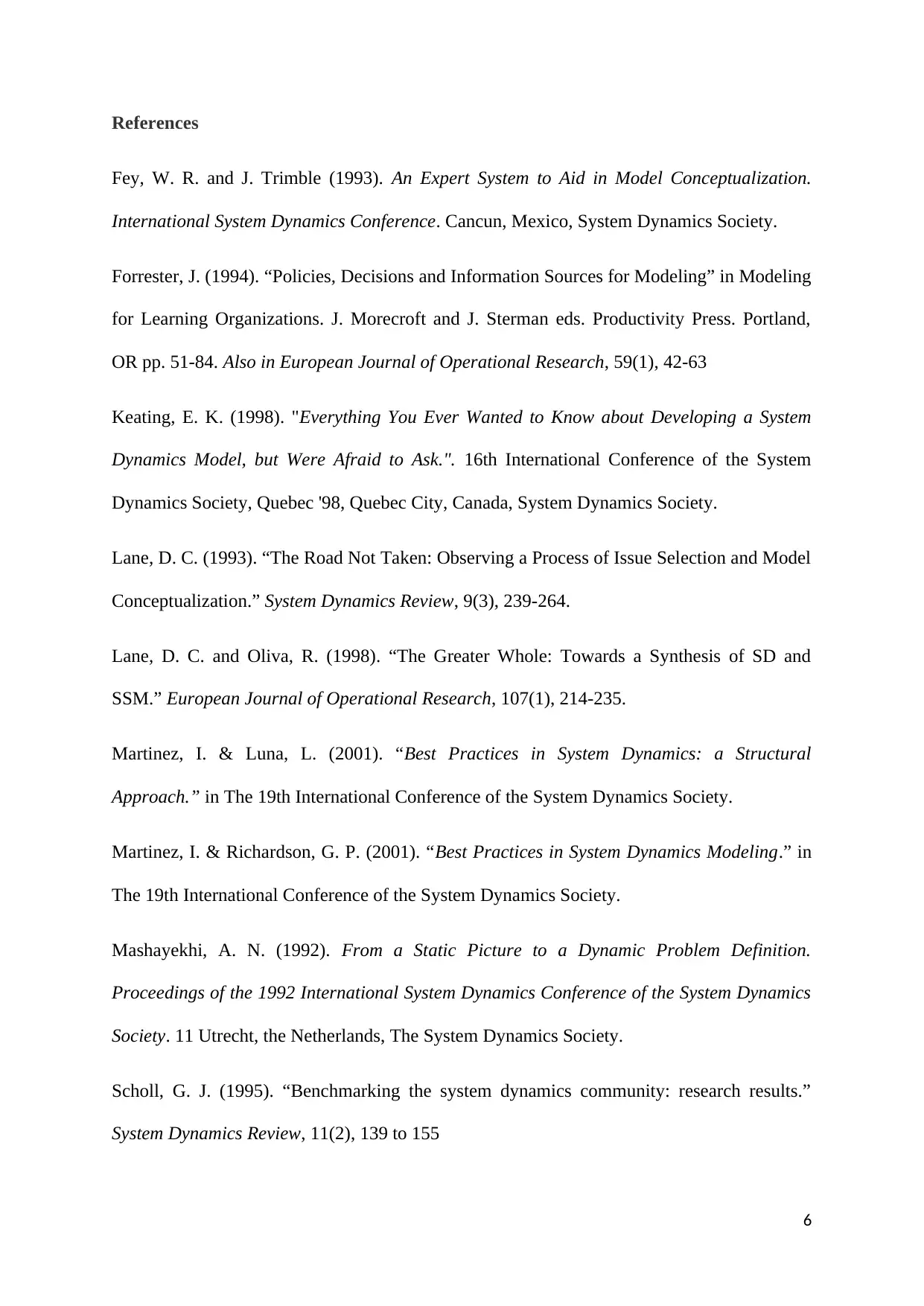
References
Fey, W. R. and J. Trimble (1993). An Expert System to Aid in Model Conceptualization.
International System Dynamics Conference. Cancun, Mexico, System Dynamics Society.
Forrester, J. (1994). “Policies, Decisions and Information Sources for Modeling” in Modeling
for Learning Organizations. J. Morecroft and J. Sterman eds. Productivity Press. Portland,
OR pp. 51-84. Also in European Journal of Operational Research, 59(1), 42-63
Keating, E. K. (1998). "Everything You Ever Wanted to Know about Developing a System
Dynamics Model, but Were Afraid to Ask.". 16th International Conference of the System
Dynamics Society, Quebec '98, Quebec City, Canada, System Dynamics Society.
Lane, D. C. (1993). “The Road Not Taken: Observing a Process of Issue Selection and Model
Conceptualization.” System Dynamics Review, 9(3), 239-264.
Lane, D. C. and Oliva, R. (1998). “The Greater Whole: Towards a Synthesis of SD and
SSM.” European Journal of Operational Research, 107(1), 214-235.
Martinez, I. & Luna, L. (2001). “Best Practices in System Dynamics: a Structural
Approach.” in The 19th International Conference of the System Dynamics Society.
Martinez, I. & Richardson, G. P. (2001). “Best Practices in System Dynamics Modeling.” in
The 19th International Conference of the System Dynamics Society.
Mashayekhi, A. N. (1992). From a Static Picture to a Dynamic Problem Definition.
Proceedings of the 1992 International System Dynamics Conference of the System Dynamics
Society. 11 Utrecht, the Netherlands, The System Dynamics Society.
Scholl, G. J. (1995). “Benchmarking the system dynamics community: research results.”
System Dynamics Review, 11(2), 139 to 155
6
Fey, W. R. and J. Trimble (1993). An Expert System to Aid in Model Conceptualization.
International System Dynamics Conference. Cancun, Mexico, System Dynamics Society.
Forrester, J. (1994). “Policies, Decisions and Information Sources for Modeling” in Modeling
for Learning Organizations. J. Morecroft and J. Sterman eds. Productivity Press. Portland,
OR pp. 51-84. Also in European Journal of Operational Research, 59(1), 42-63
Keating, E. K. (1998). "Everything You Ever Wanted to Know about Developing a System
Dynamics Model, but Were Afraid to Ask.". 16th International Conference of the System
Dynamics Society, Quebec '98, Quebec City, Canada, System Dynamics Society.
Lane, D. C. (1993). “The Road Not Taken: Observing a Process of Issue Selection and Model
Conceptualization.” System Dynamics Review, 9(3), 239-264.
Lane, D. C. and Oliva, R. (1998). “The Greater Whole: Towards a Synthesis of SD and
SSM.” European Journal of Operational Research, 107(1), 214-235.
Martinez, I. & Luna, L. (2001). “Best Practices in System Dynamics: a Structural
Approach.” in The 19th International Conference of the System Dynamics Society.
Martinez, I. & Richardson, G. P. (2001). “Best Practices in System Dynamics Modeling.” in
The 19th International Conference of the System Dynamics Society.
Mashayekhi, A. N. (1992). From a Static Picture to a Dynamic Problem Definition.
Proceedings of the 1992 International System Dynamics Conference of the System Dynamics
Society. 11 Utrecht, the Netherlands, The System Dynamics Society.
Scholl, G. J. (1995). “Benchmarking the system dynamics community: research results.”
System Dynamics Review, 11(2), 139 to 155
6
Paraphrase This Document
Need a fresh take? Get an instant paraphrase of this document with our AI Paraphraser
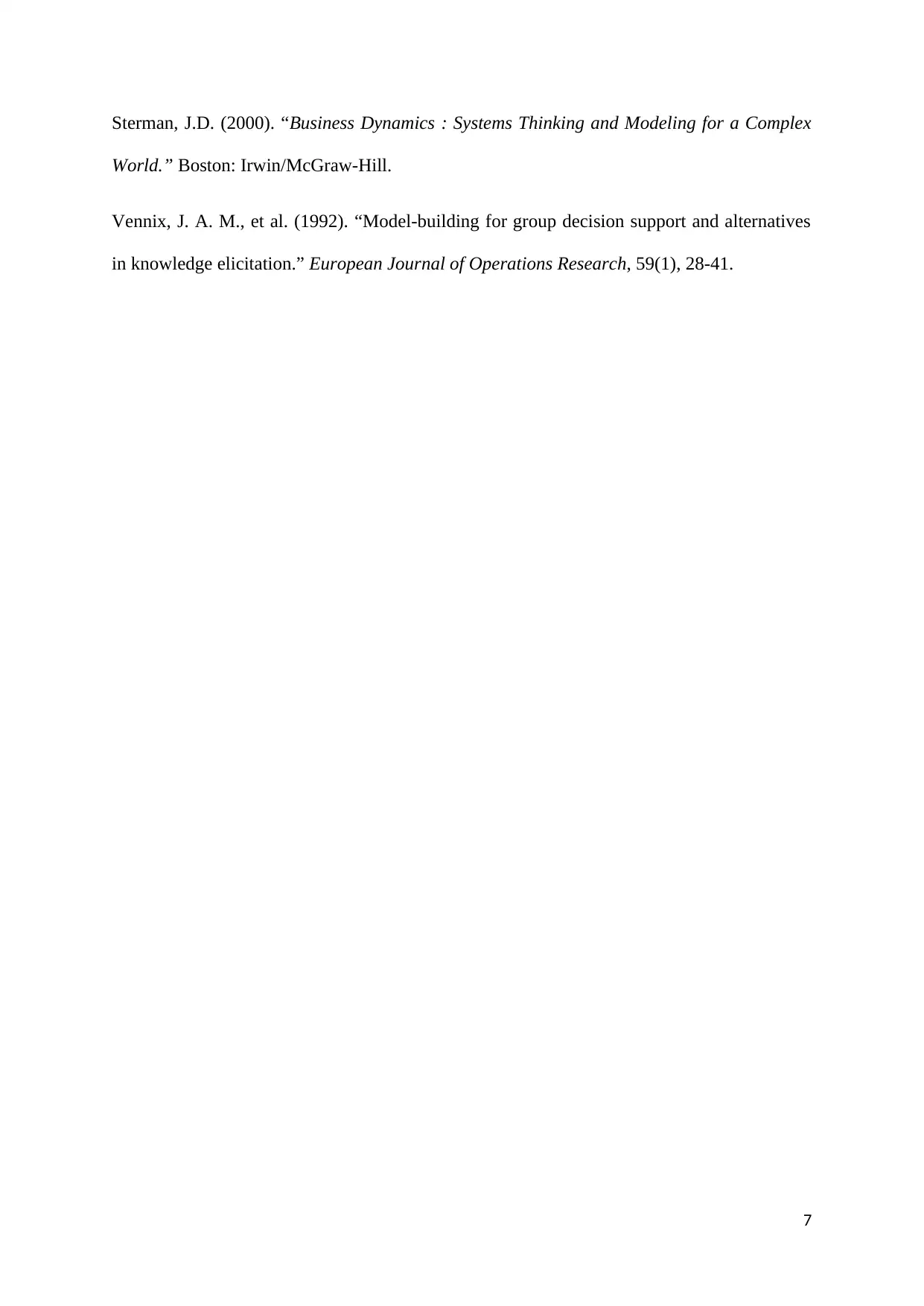
Sterman, J.D. (2000). “Business Dynamics : Systems Thinking and Modeling for a Complex
World.” Boston: Irwin/McGraw-Hill.
Vennix, J. A. M., et al. (1992). “Model-building for group decision support and alternatives
in knowledge elicitation.” European Journal of Operations Research, 59(1), 28-41.
7
World.” Boston: Irwin/McGraw-Hill.
Vennix, J. A. M., et al. (1992). “Model-building for group decision support and alternatives
in knowledge elicitation.” European Journal of Operations Research, 59(1), 28-41.
7
1 out of 8
Related Documents
Your All-in-One AI-Powered Toolkit for Academic Success.
+13062052269
info@desklib.com
Available 24*7 on WhatsApp / Email
![[object Object]](/_next/static/media/star-bottom.7253800d.svg)
Unlock your academic potential
Copyright © 2020–2025 A2Z Services. All Rights Reserved. Developed and managed by ZUCOL.





